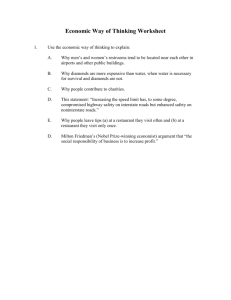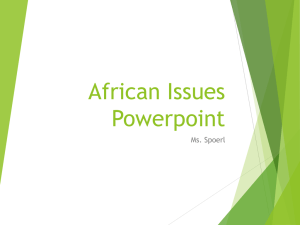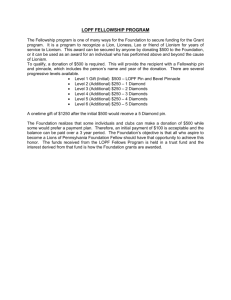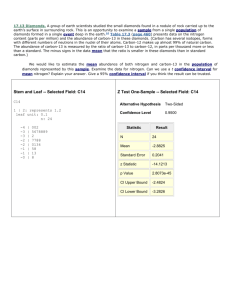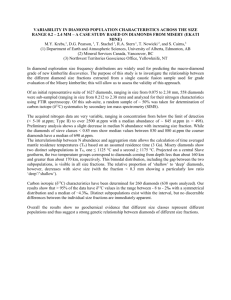DIAMONDS IN THE SHADOW CAROLINE B. COONEY LOUISIANA
advertisement
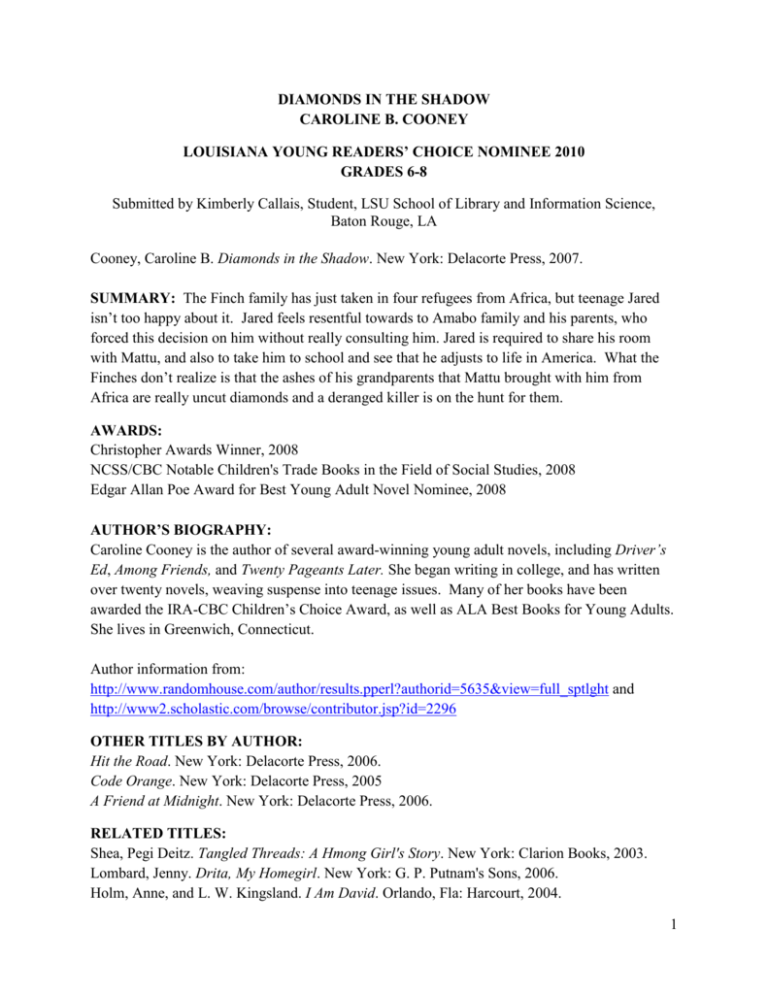
DIAMONDS IN THE SHADOW CAROLINE B. COONEY LOUISIANA YOUNG READERS’ CHOICE NOMINEE 2010 GRADES 6-8 Submitted by Kimberly Callais, Student, LSU School of Library and Information Science, Baton Rouge, LA Cooney, Caroline B. Diamonds in the Shadow. New York: Delacorte Press, 2007. SUMMARY: The Finch family has just taken in four refugees from Africa, but teenage Jared isn’t too happy about it. Jared feels resentful towards to Amabo family and his parents, who forced this decision on him without really consulting him. Jared is required to share his room with Mattu, and also to take him to school and see that he adjusts to life in America. What the Finches don’t realize is that the ashes of his grandparents that Mattu brought with him from Africa are really uncut diamonds and a deranged killer is on the hunt for them. AWARDS: Christopher Awards Winner, 2008 NCSS/CBC Notable Children's Trade Books in the Field of Social Studies, 2008 Edgar Allan Poe Award for Best Young Adult Novel Nominee, 2008 AUTHOR’S BIOGRAPHY: Caroline Cooney is the author of several award-winning young adult novels, including Driver’s Ed, Among Friends, and Twenty Pageants Later. She began writing in college, and has written over twenty novels, weaving suspense into teenage issues. Many of her books have been awarded the IRA-CBC Children’s Choice Award, as well as ALA Best Books for Young Adults. She lives in Greenwich, Connecticut. Author information from: http://www.randomhouse.com/author/results.pperl?authorid=5635&view=full_sptlght and http://www2.scholastic.com/browse/contributor.jsp?id=2296 OTHER TITLES BY AUTHOR: Hit the Road. New York: Delacorte Press, 2006. Code Orange. New York: Delacorte Press, 2005 A Friend at Midnight. New York: Delacorte Press, 2006. RELATED TITLES: Shea, Pegi Deitz. Tangled Threads: A Hmong Girl's Story. New York: Clarion Books, 2003. Lombard, Jenny. Drita, My Homegirl. New York: G. P. Putnam's Sons, 2006. Holm, Anne, and L. W. Kingsland. I Am David. Orlando, Fla: Harcourt, 2004. 1 CLASSROOM CONNECTIONS: Science Diamonds: Diamonds are Forever: Most of the time!: In this lesson, students will observe how crystals are formed. This lesson links to several websites with interactive activities on diamonds. Some of these websites may require a plug-in to be installed. The experiments require several minerals, access to lab facilitates, and printable PDF handouts are provided: http://www.thirteen.org/edonline/ntti/resources/lessons/s_diamonds/index.html Strong Chemistry: Students learn basic facts about diamonds and other gemstones. They also research a gem and create a poster to present to the class. This lesson suggests the purchase of a DVD, but also includes a link to a website on how diamonds are formed (http://www.amnh.org/exhibitions/diamonds/), which can provide the same information: http://school.discoveryeducation.com/lessonplans/programs/strongchemistry/ Diamonds Lesson Plan: Students create the molecular structure of a diamond using marshmallows and toothpicks. The website links to this lesson as three different PDF files: http://www.darkstar.cc/Discovery/Grade5Week2Science.htm Social Studies Blood Diamonds: Conflict Diamonds: Have students analyze the way that diamonds are treated in popular culture: http://www.pbs.org/newshour/extra/teachers/lessonplans/world/conflict_diamonds_1206.html Diamonds are Forever Fueling Civil Wars: Students read an article discussing how international relations contribute to the conflict over diamonds. This lesson provides a link to the article from The New York Times: http://www.nytimes.com/learning/teachers/lessons/20000802wednesday.html Child Soldiers: What’s going on? Lesson Plan on Child Soldiers: Students will study where and why children are used as child soldiers, as well as the emotional toll it takes. Contains a world map for reference, as well as stories and locations of child soldiers saved as .pdf and .doc files: http://www0.un.org/works/goingon/soldiers/lessonplan_soldiers.html. A PDF 2 version of the lesson is also available: http://www.un.org/works/Lesson_Plans/WGO/WGO_LP_CS.pdf Child Labor Module Series: An extensive series on child soldiers, this could easily be broken down into several lessons. Handouts are included, but several links are outdated. Correct links are included below. Students will learn how and where child soldiers are taken, identify the challenges faced by child soldiers through oral histories, recognize the connection between conflict and small arms, and strategies for eliminating child soldiers: http://international.uiowa.edu/centers/human-rights/documents/child_soldiers.pdf o Note: In lesson one; there is a link to an MSNBC Slideshow on child soldiers that no longer exists. However, images can be found through a Google Image search that will help students get a visual image of this issue. o Some of the testimonials included in this lesson are graphic and should be read beforehand to decide if they are appropriate for the age group of the class. o Lesson two: Here is the correct link to “Children of Conflict” from the BBC: http://www.bbc.co.uk/worldservice/people/features/childrensrights/childrenofconf lict/ and Radio Netherland’s “Child Soldiers in Liberia:” http://www.radionetherlands.nl/humanrights/soldiersliberia.html o Current link to Human Rights reports from the State Department: http://www.state.gov/g/drl/rls/hrrpt/ o Lesson four: Link to “Optional Protocol to the Convention on the Rights of the Child on the Involvement of Children in Armed Conflict,” which also includes a list of ratifications: http://www.unhchr.ch/html/menu2/6/protocolchild.htm o ILO Convention 182: http://www.ilo.org/public/english/standards/relm/ilc/ilc87/com-chic.htm o Unicef’s Voices of Youth: Explore Child’s Rights: http://www.unicef.org/voy/explore/rights/explore_rights.php Child Soldiers: Students will study the ethics and morality of using children in war: http://www.unhcr.org/cgi-bin/texis/vtx/template?page=home&src=static/teachingtools/tchcived/12-14lp.htm Class Act: You or Your Brother: Part of the British Red Cross’ humanitarian education program, this lesson allows students to understand and reflect upon other people’s feelings by considering their different points of view. The lesson is available as a PDF or Word document. http://www.redcross.org.uk/standard.asp?id=73549 3 Refugees: Refugees and Children in Our World: Students will understand the definition of a ‘refugee,’ the protections offered by the Universal Declaration of Human Rights, and how a country’s treatment of refugees reflects on its respect for human rights. http://learningtogive.org/lessons/unit189/lesson4.html What’s Going On?: Lesson Plan on Refugees: Students will discuss the difference between human needs and human wants, and how these desires change when one is displaced from home. Students will understand the problems that refugees and countries face: http://www.un.org/works/goingon/refugees/lessonplan_refugees.html The Status and Rights of Refugees: Students put themselves in a refugees shoes, and have two minutes to decide what they will take with them from home: http://www.amnestyusa.org/education/lessonplans/refugees.html Africa: Where in Africa: Students learn about the diversity and geography of Africa by creating a map of the continent, and also by reading about daily life: http://www.pbs.org/wnet/africa/tools/where/goals.html o Countries in Africa: http://geography.about.com/library/maps/blrafrica.htm o CIA World Factbook: https://www.cia.gov/library/publications/the-worldfactbook/ o Cool Planet: On the Line: http://www.oxfam.org.uk/coolplanet/ontheline/index.html African Arts and Music: Students will gain an understanding of the arts and culture of different African countries. They will create original arts and crafts, listen to African music, and create a dramatic representation based on what they learned: http://www.pbs.org/wnet/africa/tools/music/goals.html o Note: Yahooligans.com is now http://kids.yahoo.com/ o This lesson suggests a number of picture books on Africa as a supplement to the lesson. They are not necessary. o New link to Humansong’s website: http://www.humansongs.com/ o Many links on this lesson are to Africa Online, which is now a telecommunications company. However, alternative links are provided in each section. 4 o New link to ‘Key Moments in Life: Africa:” http://www.uiowa.edu/~africart/toc/chapters/KML.html o Additional site on Kente Cloth: http://www.marshall.edu/akanart/CLOTH_KENTE.HTML Language Arts Pseudonyms: It is revealed at the end of the story that the Amabo family are actually not who they have told everyone that they are. They are actually four people posing as the members of the slain Amabo family. Guess The Author: Students will write a descriptive paragraph about themselves without revealing their physical characteristics, then guess who wrote each paragraph: http://www.localschooldirectory.com/lesson-plans/id/317 Writing: Sharing – students spend a week paired up sharing books, pencils, eating lunch together; or translating for someone who is silent, journal Tell students to pick one character from the Amabo or Finch family, and journal the experience of moving to a new country, or taking in refugees. Have students brainstorm the ways that diamonds are portrayed in popular culture, through songs, television and movies, advertisements, etc. Have them write an essay on how the importance placed on diamonds affects the diamond industry in Africa. Diamond Poems: Students create a poem about themselves that is shaped like a diamond: http://www.education-world.com/a_lesson/02/lp262-01.shtml Music Songs about Diamonds Play several different songs about diamonds for students. Songs can be “Diamonds Are A Girl’s Best Friend,” from Gentlemen Prefer Blondes, “Diamonds Are Forever,” from Diamonds Are Forever and “Diamonds from Sierra Leone” by Kanye West (an edited version may be necessary). Ask students to compare and contrast the first two songs from the Kanye West song. How are the messages different? o Lyrics and a clip of “Diamonds Are A Girl’s Best Friend”: http://www.marilynmonroe.com/about/music3.htm 5 o Lyrics to “Diamonds Are Forever”: http://www.mp3lyrics.org/s/shirleybassey/diamonds-are-forever/ o Edited Lyrics to “Diamonds from Sierra Leone”: http://new.music.yahoo.com/kanye-west/tracks/diamonds-from-sierra-leone-23369328 DISCUSSION QUESTIONS: Note: Please see the “Websites” section for a link to the teacher’s guide to this novel from the publisher. 1) Why do the Amabos seem afraid of photographs? 2) Imagine going to a school with no paper, pencils, or books. How would it be different from the school you attend now? 3) How would you react if you were forced from your home and had to move to a new country? What would be the most difficult part to adjust to? The easiest? 4? What do you think of Jared’s attitude toward the Amabos? Of Mopsy’s? 5) In the book, --- says, “In a civil war, there are no good guys.” What does this mean? Do you think that this is a true statement? WEBSITES: Booknotes Readers Guide http://www.randomhouse.com/catalog/teachers_guides/9780385902786.pdf Teacher guide from Random House Teachers@Random Booktalk http://www.randomhouse.com/teachers/librarians/BookTalk_DiamondsInTheShadow.htm Booktalk for Diamonds in the Shadow from Random House. Caroline B. Cooney Biography http://www.randomhouse.com/kids/pdf/AuthorBioCBCooney.pdf A printable author biography from Random House We Generation: Free the Children http://we.freethechildren.com/ Website for Free the Children, an organization that coordinates outreach and development programs in Kenya, Sierra Leone, China, Sri Lanka, Ecuador, and India. With This Ring: Following the International Diamond Trail http://americanradioworks.publicradio.org/features/diamonds/index.html A documentary that follows the diamond trail from Africa to America’s jewelers. 6 Conflict Diamonds: Sanctions and War http://www.un.org/peace/africa/Diamond.html Information on conflict diamonds and the sanctions placed by the United Nations on the rebels in Angola and Sierra Leone. Conflict Diamonds http://www.amnestyusa.org/business-and-human-rights/conflict-diamonds/page.do?id=1051176 Information on conflict diamonds from Amnesty International Conflict Diamonds http://diamondfacts.org/conflict/ More information on conflict diamonds from the World Diamond Council. Africa for Kids http://pbskids.org/africa/ An interactive guide to Africa from PBS. Africa: One Continent, Many Worlds: http://www.nhm.org/africa/home.html Includes video, photographs, and cultural presentations from Africa, from the Natural History Museum in Los Angeles. Pseudonyms of Famous People: http://homepages.shu.ac.uk/~acsdry/quizes/pseudonym.htm A list of pseudonyms used by famous people. 7
